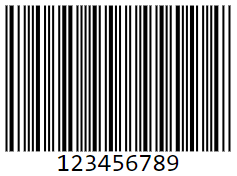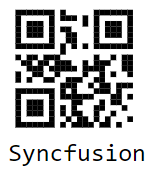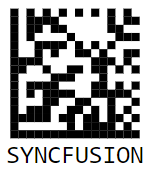Getting Started with Blazor Barcode Component
14 Nov 20255 minutes to read
This section explains how to include Blazor Barcode component in a Blazor WebAssembly app using Visual Studio or Visual Studio Code.
Prerequisites
Create a new Blazor App in Visual Studio
Create a Blazor WebAssembly App using Visual Studio via Microsoft Templates or the Syncfusion® Blazor Extension.
Install Syncfusion® Blazor BarcodeGenerator and Themes NuGet in the App
To add the Blazor Barcode component in the app, open the NuGet package manager in Visual Studio (Tools → NuGet Package Manager → Manage NuGet Packages for Solution), search and install Syncfusion.Blazor.BarcodeGenerator and Syncfusion.Blazor.Themes. Alternatively, run the following Package Manager commands:
Install-Package Syncfusion.Blazor.BarcodeGenerator -Version 32.1.19
Install-Package Syncfusion.Blazor.Themes -Version 32.1.19NOTE
Syncfusion® Blazor components are available on nuget.org. Refer to NuGet packages topic for available NuGet packages list with component details.
Prerequisites
Create a new Blazor App in Visual Studio Code
Create a Blazor WebAssembly App using Visual Studio Code via Microsoft Templates or the Syncfusion® Blazor Extension.
Alternatively, create a WebAssembly application using the following commands in the terminal(Ctrl+`).
dotnet new blazorwasm -o BlazorApp
cd BlazorAppInstall Syncfusion® Blazor BarcodeGenerator and Themes NuGet in the App
- Press Ctrl+` to open the integrated terminal in Visual Studio Code.
- Ensure the terminal is opened at the project root directory where the .csproj file is located.
- Run the following command to install a Syncfusion.Blazor.BarcodeGenerator and Syncfusion.Blazor.Themes NuGet package and ensure all dependencies are installed.
dotnet add package Syncfusion.Blazor.BarcodeGenerator -v 32.1.19
dotnet add package Syncfusion.Blazor.Themes -v 32.1.19
dotnet restoreNOTE
Syncfusion® Blazor components are available in nuget.org. Refer to NuGet packages topic for available NuGet packages list with component details.
Register Syncfusion® Blazor Service
Open ~/_Imports.razor file and import the Syncfusion.Blazor namespace.
@using Syncfusion.Blazor
@using Syncfusion.Blazor.BarcodeGeneratorNow, register the Syncfusion® Blazor Service in the ~/Program.cs file of the Blazor WebAssembly App.
using Microsoft.AspNetCore.Components.Web;
using Microsoft.AspNetCore.Components.WebAssembly.Hosting;
using Syncfusion.Blazor;
var builder = WebAssemblyHostBuilder.CreateDefault(args);
builder.RootComponents.Add<App>("#app");
builder.RootComponents.Add<HeadOutlet>("head::after");
builder.Services.AddScoped(serviceProvider => new HttpClient { BaseAddress = new Uri(builder.HostEnvironment.BaseAddress) });
builder.Services.AddSyncfusionBlazor();
await builder.Build().RunAsync();
....Add stylesheet and script resources
The theme stylesheet and script can be accessed from NuGet through Static Web Assets. Include the stylesheet and script references in the <head> section of the ~/index.html file.
<head>
....
<link href="_content/Syncfusion.Blazor.Themes/bootstrap5.css" rel="stylesheet" />
<script src="_content/Syncfusion.Blazor.Core/scripts/syncfusion-blazor.min.js" type="text/javascript"></script>
</head>NOTE
Check out the Blazor Themes topic to discover various methods (Static Web Assets, CDN, and CRG) for referencing themes in the Blazor application. Also, check out the Adding Script Reference topic to learn different approaches for adding script references in the Blazor application.
Add Blazor Barcode component
Add the Syncfusion® Blazor Barcode component in ~/Pages/Index.razor file.
<SfBarcodeGenerator Width="200px" Height="150px" Type="@BarcodeType.Codabar" Value="123456789"></SfBarcodeGenerator>- Press Ctrl+F5 (Windows) or ⌘+F5 (macOS) to launch the application. This renders the Syncfusion® Blazor Barcode component in the default web browser.

NOTE
Adding QR Generator control
Add a QR code in our barcode generator component.
<SfQRCodeGenerator Width="200px" Height="150px" Value="Syncfusion"></SfQRCodeGenerator>
Adding Data Matrix Generator control
Add a Data Matrix code in our barcode generator component.
<SfDataMatrixGenerator Width="200" Height="150" Value="SYNCFUSION"></SfDataMatrixGenerator>
NOTE
Explore the Blazor Barcode Generator example that shows you how to render and configure the barcode.